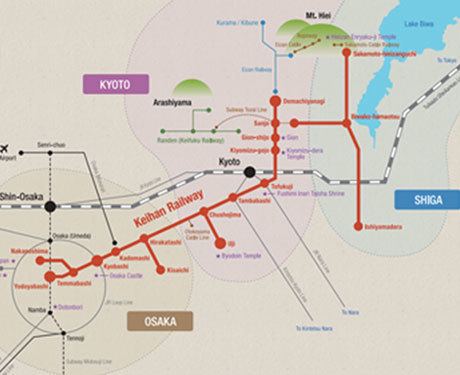Founded 1949 | CEO Yoshifumi Kato (2011–) | |
 | ||
Keihan electric railway across uji river
Keihan Electric Railway Co., Ltd. (京阪電気鉄道株式会社, Keihan Denki Tetsudō Kabushiki-gaisha) (TYO: 9045) is a Japanese railway operator in Osaka, Kyoto, and Shiga Prefectures. It is known as "Keihan" (京阪), "Keihan Dentetsu" (京阪電鉄) or "Keihan Densha" (京阪電車).
Contents
- Keihan electric railway across uji river
- History
- Lines
- Keihan Lines
- tsu Lines
- Other lines
- Closed lines
- Unbuilt line
- Rolling stock
- Fares
- Keihan Lines Keihan Main Line Oto Line Nakanoshima Line Katano Line Uji Line
- Cable line
- Etymology
- Other businesses
- References
History
Keihan started its operation between Osaka and Kyoto in 1910. It was the first electric railway to connect these two cities, and the first line on the left bank of Yodo River. Keihan later purchased the lines in the Ōtsu area (Ōtsu Lines).
In the 1920s, Keihan built another Osaka-Kyoto line through its subsidiary Shinkeihan Railway (新京阪鉄道, Shin-keihan-tetsudō), which merged into Keihan in 1930. This line is now known as Hankyu Kyoto Line.
In 1943, with the power given by the Land Transport Business Coordination Act (陸上交通事業調整法, rikujō-kōtsū-jigyō-chōsei-hō) (Act No. 71 of 1938), the wartime government of Japan forced Keihan to merge with Hanshin Kyūkō Railway to form Keihanshin Kyūkō Railway (京阪神急行電鉄, Keihanshin Kyūkō Dentetsu). In 1949, the pre-war Keihan operations, except for Shinkeihan lines, restored independence under the original corporate name. Keihanshin Kyūkō Railway later changed the name to present Hankyu Railway.
Lines
The lines operated by Keihan are grouped into Keihan Lines and Ōtsu Lines. The former operates between Kyoto and Osaka with long formation of larger rolling stock. The latter runs Kyoto and Ōtsu with more tram-like cars. The entire network has 1,435 mm (4 ft 8 1⁄2 in) standard gauge double track.
Keihan Lines
Ōtsu Lines
Other lines
Closed lines
Unbuilt line
Rolling stock
Keihan fleet as of October 2008
Keihan Lines
Ōtsu Lines
Fares
Train fare varies based on travel distance. As of January 1, 2009, IC cards (PiTaPa and ICOCA) are accepted on the Keihan Lines and the Otsu Lines, but not on the Cable Line. The fare rate was changed on April 1, 2014 to reflect the change in the rate of consumption tax from 5% to 8%.
Keihan Lines (Keihan Main Line, Oto Line, Nakanoshima Line, Katano Line, Uji Line)
Cable line
200 yenEtymology
The name Keihan is derived from the words Kyoto and Osaka in Japanese. The characters for Kyoto are 京都 and Osaka's are 大阪. The first character from Kyoto and the second from Osaka make 京阪, which can be read "Keihan".
Other businesses
Keihan also operates (through the subsidiaries) other businesses such as bus, taxi, water bus, hotel, department store and amusement park, mainly in the area along its railway system.
